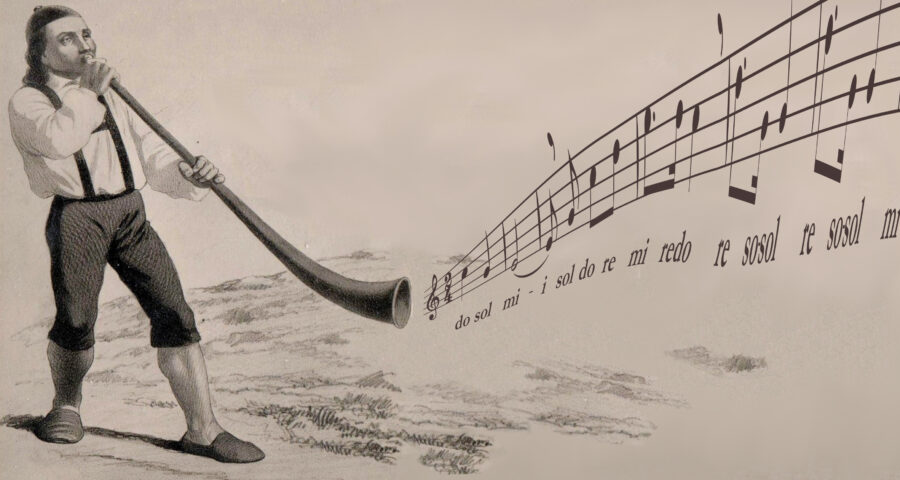The alphorn presents such a unique, timeless beauty in its natural production of the overtone series; a sound that captivates with its resonance and simplicity. However, the absence of any kind of keys or valves means that they player is entirely responsible for vividly hearing the correct pitch before playing it. Unlike a piano or a fretted guitar string, the alphorn will never inform the player what the correct pitch is. For this reason, it requires a very clear musical intention and sense of inner hearing that needs to be developed in its own right, just as much as any component of playing technique. The great music educator Zoltan Kodály described this by saying, “we should read music in the same way that an educated adult will read a book: in silence, but imaging the sound.”ildend.”
Examples in F
The most essential process to develop this skill is singing. To play beautifully and accurately, one needs to practice singing in the same way that they practice their articulation, range, or any other facet of tone production. Singing provides an opportunity to connect to musical intuition without concern about technique and enjoy the innate ability to create music without an instrument. Practically, it reveals when an acute sense of pitch is present, and when it needs to be refined.
Whatever pitch one hears and sings is ultimately what they buzz through the mouthpiece and what comes out of the bell of the horn. Therefore, buzzing after singing is an essential step in connecting the mind to the horn. It is the closest exercise to singing on the instrument itself, representing what the player hears internally and how well they can reproduce it with their embouchure.
By singing and developing the ear, the alphornist will find that the instrument becomes not only much easier to play, but a natural extension of their voice. They will play more accurately, more musically, and with greater conviction.
Singing & Pitch Training
Solfege, or singing on syllables, is a centuries-old system to train one’s sense of pitch. Repeating these syllables allows the hornist to reinforce pitch relationships and identify musical patterns. Each pitch is labelled starting with C as do and following up the scale, D is re, E is mi, etc.

The syllables are a device for accurately relating the intervals encountered in the music, establishing a strong sense of relative pitch. Once a musician can sing each pitch on its respective syllable, they can fluently sightread new music by rearranging the syllables as they appear in any melody. This works much in the same way that letters allow readers to construct words and sentences in their minds.
The solfege of the opening phrase of “Chorale fur Luzern” appears as follows:

Singing Exercise
Begin by singing this opening phrase on solfege, buzzing it on the mouthpiece, and playing it on the horn. Resist the temptation to play any of the pitches on the horn before singing them, relying only on the ear.
Next, sing the second horn part on solfege. Only three syllables are necessary: mi, sol, and do. Then, buzz the second horn part on the mouthpiece and play it on the horn.

As a final and more advanced step, sing the second horn part while clapping the rhythm of the first horn part. This exercises the inner ear while building polyphonic sense, the ability to think and hear in more than one part. This is essential when participating as part of an ensemble.
Inner Hearing Exercise
The opening to “Uf de Bänkliap” uses the same syllables as “Chorale fur Luzern”: do, re, mi, and sol.

Sing the opening on solfege:

Practice inner hearing by singing “Uf de Bänkliap” again, this time tapping or clapping the rhythm and only singing the starred notes out loud, while vividly hearing the other pitches and singing them internally.

Repeat the process, instead buzzing and then playing on the horn. This kind of exercise can be applied to any alphorn repertoire; practice singing only certain types of rhythms aloud (only eighths or quarters, etc.), certain pitches aloud (only sol or mi, etc), or certain beats aloud (only beat 2 of every measure, etc.). In all cases, strive to sing as loudly in your mind as possible when not singing aloud. The more real the voice in the mind, the more accurate the buzzing and pitch on the horn.
The Purpose of Our Musicianship
The most beautiful alphorn playing comes with great intention, as direct reflection of the musical mind and heart. The sound of instrument is beautiful, but it is the breath and feeling of the player that gives it life. Any alphornist will best serve the legacy of this beautiful instrument by developing themselves to not only to have proficient technique, but to be the highest level musician possible.
 Further information
Further information
German language website on solmization: solmisieren.de.
Here you can also download my Somnization Cheat Sheet.

Leave a Reply